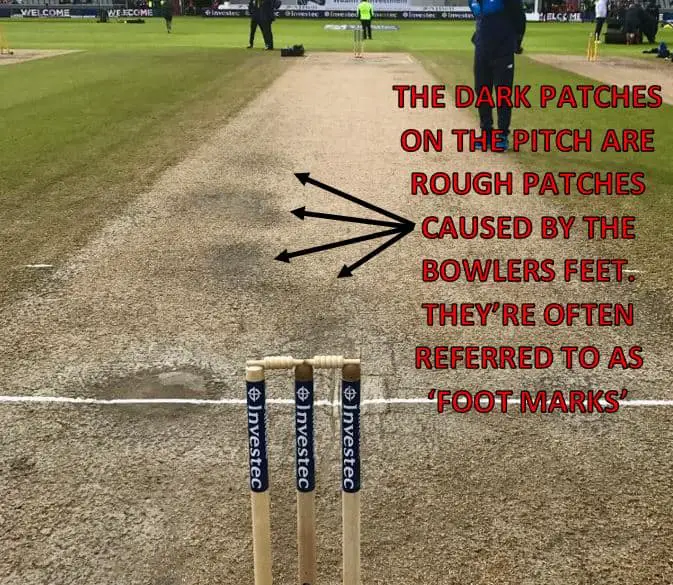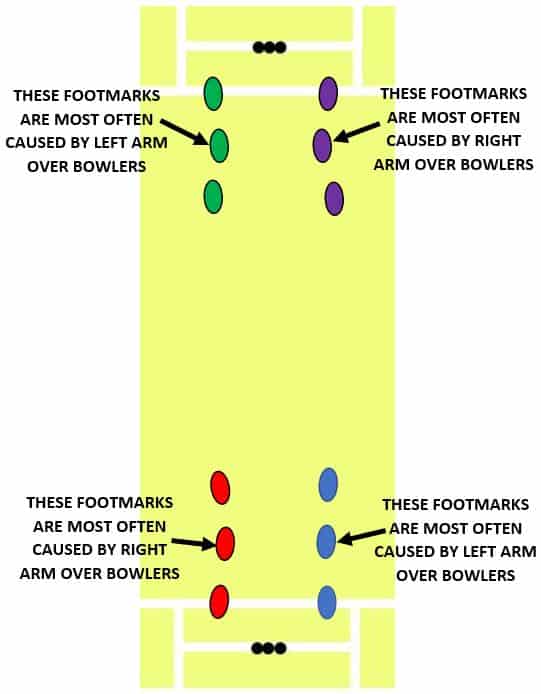Facing spin bowling in cricket can be a tough proposition for any batsman. The best spinners will be able to fool you with their variations, unsettle your rhythm with their changes of pace and perplex you with adjustments in the amount of flight they give the ball. However, there is one thing that allows a spin bowler to be even tougher to bat against than usual, and that is when they have the opportunity to bowl into the ‘rough’. If you’re not sure what the rough is, or how or why it impacts the performance of a spin bowler, stay tuned because I have all of the answers that you seek!
So, what is ‘bowling in the rough’ in a cricket context?
‘Bowling in the rough’ refers to how a spin bowler will try to bowl the ball into driest, most scuffed up areas of the pitch in order to extract more spin from the surface. Landing the ball in the rough often leads to the ball spinning and bouncing unpredictably, thus becoming harder for batsmen to play.
The rough areas of the pitch are usually foot-sized patches that are created by the fast bowlers when they slam their feet onto the pitch as they bowl and follow through. This is why they are often also referred to as ‘foot marks’. Over the course of a test match these areas get more and more scuffed up, especially in hot countries with drier climates, and this can become quite problematic for batsmen.

When Does Rough Appear?
Rough patches are more likely to appear on the pitch in the following scenarios:
- A test match is being played – A test match takes place over 5 days, which gives plenty of time for rough areas of the pitch to appear. Significant rough patches will usually start to form about midway through the test once the first innings’ have concluded and will be at their worst during the final innings of the match. Rough isn’t seen as much in shorter versions of cricket like ODI’s because 100 overs isn’t really long enough for significant wear and tear to occur.
- A bowler has an action that contributes to it – Some fast bowlers are perfectly suited to creating rough on the pitch. Heavier, taller bowlers will usually cause more of a disturbance when they slam their feet down than a smaller bowler would. Additionally, bowlers that drag and twist their feet on the surface as part of their action can also aid the creation of rough patches.
- In test matches in warmer nations – As I’ve already mentioned, warmer and drier climates are perfect for creating rough patches on the pitch. This is why you’re much more likely to see spinners bowling into the rough in countries like Australia and India, and less likely to see it in England or New Zealand unless they have a decent spell of really hot weather!
Where Does Rough Appear?
Rough patches will appear anywhere on the pitch that has been exposed to the follow through of fast bowlers for an extended period of time. The diagram below shows where rough patches (foot marks) usually occur, and the types of bowlers that would most likely create them.

Why Is Bowling In The Rough So Dangerous?
As I’ve already mentioned, bowling in the rough is so dangerous because it causes the ball to behave in unpredictable ways, and as a result this puts a lot of doubt in the mind of the batsmen. Some balls may hit the rough and not spin much at all, but the next delivery may hit the same spot and explode in towards the batsman, turning much more sharply than usual. Additionally, some balls may bounce normally out of the rough, but some will also bounce a lot more. Some may also skid along the deck towards the batsman! All of this behaviour is literally impossible to predict, for both the bowler and the batsman. This is why it’s so hard to deal with. When a batsman sees the ball land in the rough, the thought that something crazy could be about to happen can take over their mind. If they allow their mind to get overtaken like this, it can cause them to forget to play the ball on its merits – which is a huge win for the spin bowler and makes the batsman more prone to mistakes.
To make things extra dangerous for the batsman the bowling side needs to have a spin bowler that can exploit those rough areas by bowling the ball into them consistently. Additionally, if you have a spin bowler who spins the ball in towards the batsman, this makes the rough even more deadly. For example, a bowler like Ravindra Jadeja would be perfect for bowling into the rough outside Ben Stokes’ off stump because he’s a left arm off spinner that primarily spins the ball in to left hand batsmen. On the other hand, Nathan Lyon would make things very tough for Joe Root when bowling into any rough outside Joe Root’s off stump because Lyon is a right arm off spin bowler who spins the ball in towards the right handers.
Spinners who primarily spin the ball away from the batsman are not as dangerous when bowling into the rough, because the batsman can just choose to leave the ball. When the ball is spinning in towards them out of the rough, they don’t really have the option to leave it, which means there’s a chance they could be bowled or misjudge a shot and pop the ball up in the air.
Ideally, a team will have one spinner that is capable of spinning the ball both ways, or they could include two spinners which can each spin the ball in a different direction. This is the current model of the Indian test team, which contains both Jadeja (who spins the ball right to left) and Ashwin (who mainly spins the ball left to right) within it. Having both of these guys in the side means that they always have a bowler that can exploit the rough and spin the ball into the batsman, no matter who is at the crease.
Conclusion
I hope this post has helped you to understand what the ‘rough’ is and why bowlers might choose to bowl into it. Spin bowlers are always under pressure when rough patches appear on the pitch, because there is an expectation from the rest of the team, commentators and fans that they will be able to bowl long spells and take a hat full of wickets. Some spinners get overwhelmed by this pressure and start focusing too hard on bowling magic deliveries, when in reality all they really need to do is execute the basics well and let the natural variation from the rough do the work for them.
If you have any other cricketing questions that you’d like the answer to, feel free to head over to my general cricket questions page and see if I’ve covered it there!
